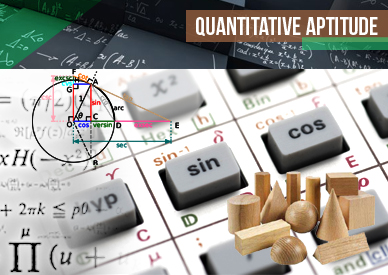Target SBI PO Mains- Day 14 – Aptitude – DI Table

Target SBI PO Mains- Day 14 – Aptitude – DI Table
Direction (1-5): Classification of 100 Students Based on the Marks Obtained by them in Physics and Chemistry in an Examination.
| Subject | Marks out of 50 | ||||
| 40 and above | 30 and above | 20 and above | 10 and above | 0 and above | |
| Physics | 9 | 32 | 80 | 92 | 100 |
| Chemistry | 4 | 21 | 66 | 81 | 100 |
| Average (Aggregate) | 7 | 27 | 73 | 87 | 100 |
1. What is the different between the number of students passed with 30 as cut-off marks in Chemistry and those passed with 30 as cut-off marks in aggregate?
(a) 3
(b) 4
(c) 5
(d) 6
(e) None of these
2. If at least 60% marks in Physics are required for pursuing higher studies in Physics, how many students will be eligible to pursue higher studies in Physics?
(a) 27
(b) 32
(c) 34
(d) 41
(e) None of these
3. The percentage of number of students getting at least 60% marks in Chemistry over those getting at least 40% marks in aggregate, is approximately?
(a) 21%
(b) 27%
(c) 29%
(d) 31%
(e) None of these
4. The number of students scoring less than 40% marks in aggregate is?
(a) 13
(b) 19
(c) 20
(d) 27
(e) None of these
5. If it is known that at least 23 students were eligible for a Symposium on Chemistry, then the minimum qualifying marks in Chemistry for eligibility to Symposium would lie in the range?
(a) 40-45
(b) 30-40
(c) 20-30
(d) Below 20
(e) None of these
Directions (6-10): Financial statement of a company over the years (Rupees in Lakhs)
6. During which year did the ‘Net Profit’ exceed Rs. 1 Crore for the first time
(a) 1981-82
(b) 1982-83
(c) 1984-85
(d) 1985-86
7. During which year was the ‘Gross Turnover’ closet to the thrice the ‘profit before interest and depreciation’?
(a) 1981-82
(b) 1982-83
(c) 1984-85
(d) 1985-86
8. During which of the given year did the ‘net profit’ form the highest proportion of the ‘profit before interest and depreciation’?
(a) 1981-82
(b) 1982-83
(c) 1984-85
(d) 1985-86
9. Which of the following registered the lowest increase in terms of rupees from the year 1980-81 to year 1985-86?
(a) 1981-82 to 1982-83
(b) 1982-83 to 1983-84
(c) 1983-84 to 1984-85
(d) 1984-85 to 1985-86
10. The ‘Gross Turnover’ for 1982-83 is about what percent of the ‘Gross Turnover’ for 1984-85?
(a) 40
(b) 50
(c) 60
(d) 70
Read Previous Set – Target SBI PO Mains- Day 13 – Aptitude – DI Table


